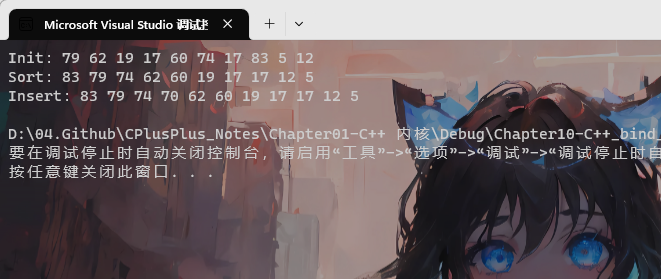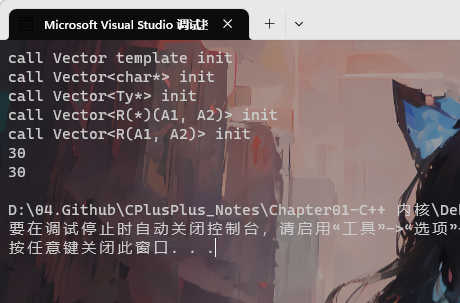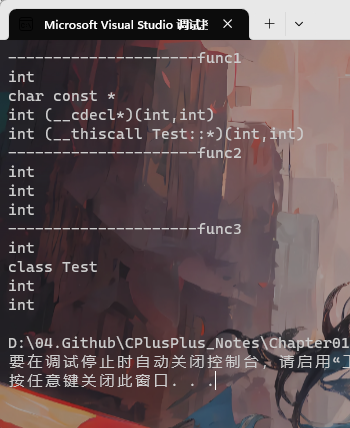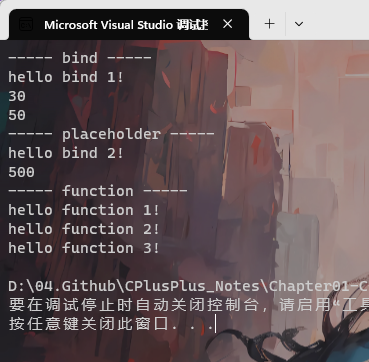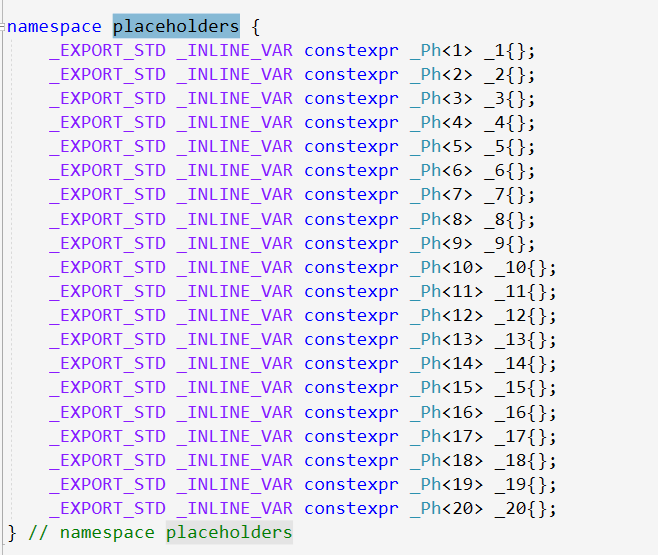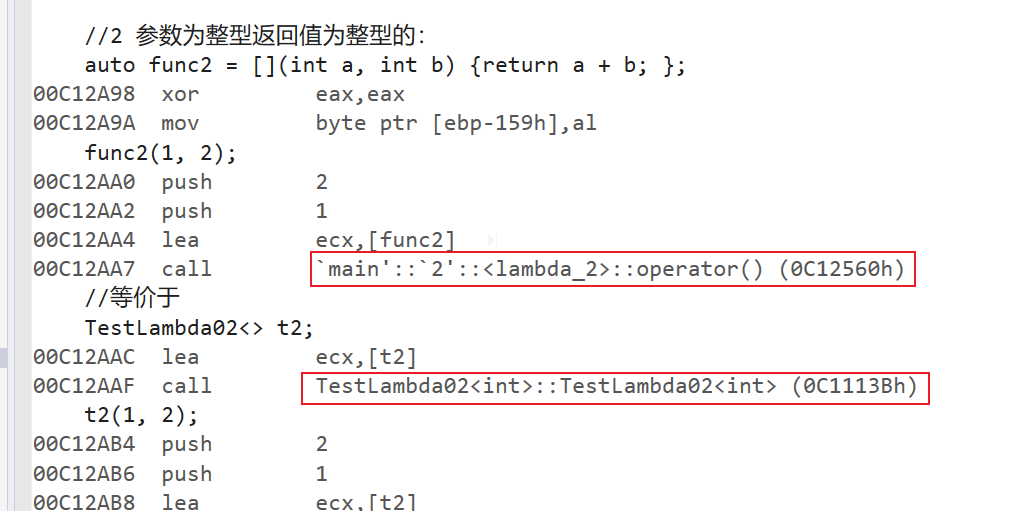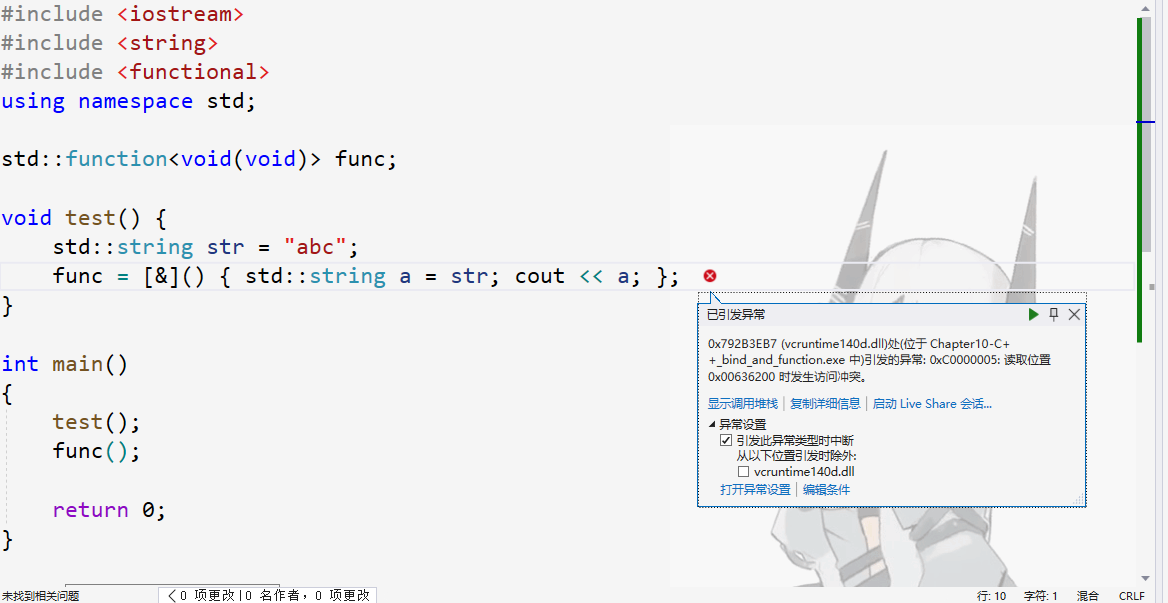本节分为四部分:
C++ STL 中的绑定器
function 示例和实现
bind 和 function 实现线程池
lambda 表达式
1. C++ STL 中的绑定器 1. 介绍绑定器 1 2 3 std::bind1st
以上两个函数用于将一个 二元函数对象 转换为 一元函数对象 。
bind 意思为:绑定 ,1st 代表 first;2nd 代表 second,说明如下:
1 2 3 4 5 template <typename F, typename T>std::binder1st<F> bind1st (const F& f, const T& x) ;template <typename F, typename T >std::binder2nd<F> bind2nd ( const F& f, const T& x )
将给定的参数 x 绑定到 二元函数对象 F 的第一个或第二个形参。也就是说,将 x 存储在该包装器中,如果调用该包装器,则将 x 作为 F 的第一个或第二个形参传递。
bind1st:相当于操作:x Operation value == operator() 的第一个形参变量绑定成一个确定的值。bind2nd:相当于操作:Operation value x == operator() 的第二个形参变量绑定成一个确定的值。
2. 实例 1 2 3 4 5 6 7 8 9 10 11 12 13 14 15 16 17 18 19 20 21 22 23 24 25 26 27 28 29 30 31 32 33 34 35 36 37 38 39 40 41 42 43 44 45 46 47 48 49 50 51 52 53 54 55 56 57 58 59 60 #include <iostream> #include <vector> #include <functional> #include <algorithm> #include <ctime> using namespace std;template <typename Container>void showContainer (Container& con) typename Container::iterator it = con.begin ();for (; it != con.end (); it++)" " ;int main () int > vec;srand (time (nullptr ));int i = 0 ;for (i = 0 ; i < 10 ; ++i)push_back (rand () % 100 + 1 );"Init:" ;showContainer (vec);"Sort:" ;sort (vec.begin (), vec.end (), greater <int >());showContainer (vec);int >::iterator it = find_if (begin (),end (),bind1st (greater <int >(), 70 )if (it != vec.end ())insert (it, 70 );"Insert:" ;showContainer (vec);return 0 ;
3. 实现原理
find_if
1 2 3 4 5 6 7 8 9 10 11 12 13 14 15 16 17 18 19 20 21 template <class _InIt , class _Pr >_NODISCARD _CONSTEXPR20 _InIt find_if ( _InIt _First, const _InIt _Last, _Pr _Pred ) auto _UFirst = _Get_unwrapped(_First);const auto _ULast = _Get_unwrapped(_Last);for (; _UFirst != _ULast; ++_UFirst) {if (_Pred(*_UFirst)) {break ;return _First;
其中第三个参数 _Pred 是一个一元函数对象
bind1st
1 2 3 4 5 6 7 8 9 10 11 template <class _Fn , class _Ty >_NODISCARD binder1st<_Fn> bind1st ( const _Fn& _Func, const _Ty& _Left) typename _Fn::first_argument_type _Val(_Left);return binder1st <_Fn>(_Func, _Val);
它是一个函数模板,返回一元函数对象 binder1st
bind2nd
1 2 3 4 5 6 7 8 9 10 11 12 13 14 15 16 17 18 19 20 21 22 23 24 25 26 27 28 29 30 31 32 33 34 35 36 37 38 39 40 41 42 template <class _Fn >class binder1st public unary_function<typename _Fn::second_argument_type,typename _Fn::result_type>public :typedef unary_function<typename _Fn::second_argument_type,typename _Fn::result_type> _Base;typedef typename _Base::argument_type argument_type;typedef typename _Base::result_type result_type;binder1st (const _Fn& _Func,const typename _Fn::first_argument_type& _Left)op (_Func)value (_Left)result_type operator () (const argument_type& _Right) const { return (op (value, _Right));result_type operator () (argument_type& _Right) const { return (op (value, _Right));protected :typename _Fn::first_argument_type value;
一元函数对象默认构造函数接受两个参数, op 和 value。赋值运算符接收一个参数,并使用传入的 op 和 vaule 进行运算:op(value, _Right)
4. 实现 1 2 3 4 5 6 7 8 9 10 11 12 13 14 15 16 17 18 19 20 21 22 23 24 25 26 27 28 29 30 31 32 33 34 35 36 37 38 39 40 41 42 43 44 45 46 47 48 49 50 51 52 53 54 55 56 57 58 59 60 61 62 63 64 65 66 67 68 69 70 71 72 73 74 75 76 77 78 79 80 81 82 83 84 85 86 87 88 89 90 91 92 93 94 95 96 97 98 99 100 101 102 103 104 105 106 107 108 109 110 111 112 #include <iostream> #include <vector> #include <functional> #include <algorithm> #include <ctime> using namespace std;template <typename Container>void showContainer (Container& con) typename Container::iterator it = con.begin ();for (; it != con.end (); it++)" " ;template <typename Iterator, typename Compare>Iterator my_find_if (Iterator first, Iterator last, Compare comp) for (; first != last; first++)if (comp (*first))return first;return last;template <class Compare , class T >class _mybind1st public :bool operator () (const T& second) {return _comp(_val, second);private :template <typename Compare, typename T>_mybind1st<Compare, T> mybind1st (Compare comp, const T& val) return _mybind1st<Compare, T>(comp, val);int main () int > vec;srand (time (nullptr ));for (int i = 0 ; i < 20 ; ++i)push_back (rand () % 100 + 1 );"Init:" ;showContainer (vec);sort (vec.begin (), vec.end (), greater <int >());"Sort:" ;showContainer (vec);int >::iterator it1 = my_find_if (begin (), end (),mybind1st (greater <int >(), 70 )if (it1 != vec.end ())insert (it1, 70 );"Insert:" ;showContainer (vec);return 0 ;
2. function 示例和实现 function 是一个函数包装器模板,最早来自 boost 库。在 c11 标准中将其纳入标准库。该函数包装器模板可以包装任何类型的可调用元素,例如普通函数和函数对象 。
function 最大的作用就是保留可调用元素的类型 。
解决绑定器,函数对象,lambda 表达式只能使用在一条语句中的问题;
定义:传递一个 _Fty function type 希望传递一个函数类型
1 2 3 4 5 6 7 8 9 10 11 12 13 14 15 16 17 18 template <class _Fty >class function public _Get_function_impl<_Fty>::typeprivate :typedef typename _Get_function_impl<_Fty>::type _Mybase;public :function () noexcept
1. function的应用 1 2 3 4 5 6 7 8 9 10 11 12 13 14 15 16 17 18 19 20 21 22 23 24 25 26 27 28 29 30 31 32 33 34 35 36 37 38 39 40 41 42 43 44 45 46 47 48 49 50 51 52 53 54 55 56 57 58 59 60 61 #include <iostream> #include <vector> #include <functional> #include <algorithm> #include <ctime> #include <string> using namespace std;void hello1 () "hello world1!" << endl;void hello2 (const string& str) int sum (int a, int b) "Sum:" ;return a + b;class Test public :void hello (string str) int main () void ()> func1 = hello1;func1 ();void (string)> func2 = hello2;func2 ("hello world2!" );int (int , int )> func3 = sum;sum (2 , 3 );int (int , int )> func4 =int a, int b) ->int { return a + b; };"function::operator():" << func4 (2 , 5 ) << endl;void (Test*, string)> func5 = &Test::hello;new Test ();func5 (t, "call Test::hello!" );return 0 ;
1 2 3 4 void (Test*, string)> func5 = &Test::hello;func5 (&Test (), "call Test::hello!" );
原因:
其实是可以实现取地址的,对象是在站内构造的,可以通过栈偏移指向;但是编译器不支持,无法实现兼容。
报左值引用错误是因为仿函数 要用,上面初始化的仿函数是个 this call,要提供 this,而 this 是结构体的指针,无法通过取地址实现,而且临时构造不能允许取地址。
test() 的声明周期就那一行,结束就被销毁了是个右值,只有左值能取址。
2. 模板的完全特例化和部分特例化 对于下面的 compare,对于 char 类型的比较不能满足实际的需要,因此对 compare 特例化一个版本 compare<const char *>
1 2 3 4 5 6 7 8 9 10 11 12 13 14 15 16 17 18 19 20 21 22 23 24 25 26 27 28 29 #include <iostream> #include <vector> #include <functional> #include <algorithm> #include <ctime> #include <string> using namespace std;template <typename T>bool compare (T a, T b) "template compare" << endl;return a > b;template <>bool compare <const char *>(const char * a, const char * b)"compare<const char*>" << endl;return strcmp (a, b) > 0 ;int main () compare (10 , 20 );compare ("aaa" , "bbb" );return 0 ;
匹配原则:有完全特例化则先匹配完全特例化,其次部分特例化,最后函数模板
1 2 3 4 5 6 7 8 9 10 11 12 13 14 15 16 17 18 19 20 21 22 23 24 25 26 27 28 29 30 31 32 33 34 35 36 37 38 39 40 41 42 43 44 45 46 47 48 49 50 51 52 53 54 55 56 57 58 59 60 61 62 63 64 65 66 67 68 69 70 #include <iostream> #include <vector> #include <functional> #include <algorithm> #include <ctime> #include <string> using namespace std;template <class T >class Vector public :Vector () { cout << "call Vector template init" << endl; }template <> class Vector <char *>public :Vector () { cout << "call Vector<char*> init" << endl; }template <class Ty >class Vector <Ty*>public :Vector () { cout << "call Vector<Ty*> init" << endl; }template <class R , class A1 , class A2 >class Vector <R (*)(A1, A2)>public :Vector () { cout << "call Vector<R(*)(A1, A2)> init" << endl; }template <class R , class A1 , class A2 >class Vector <R (A1, A2)>public :Vector () { cout << "call Vector<R(A1, A2)> init" << endl; }int sum (int a, int b) return a + b; }int main () int > vec1;char *> vec2;int *> vec3;int (*)(int , int )> vec4;int (int , int )> vec5;typedef int (*PFUNC1) (int , int ) pfunc1 (10 , 20 ) << endl;typedef int PFUNC2 (int , int ) 10 , 20 ) << endl;return 0 ;
实参推演:
1 2 3 4 5 6 7 8 9 10 11 12 13 14 15 16 17 18 19 20 21 22 23 24 25 26 27 28 29 30 31 32 33 34 35 36 37 38 39 40 41 42 43 44 45 46 47 48 49 50 51 52 53 54 #include <iostream> #include <typeinfo> using namespace std;int sum (int a, int b) return a + b; }template <typename T>void func (T a) typeid (T).name () << endl;template <typename R, typename A1, typename A2>void func2 (R(*a)(A1, A2)) typeid (R).name () << endl;typeid (A1).name () << endl;typeid (A2).name () << endl;class Test public :int sum (int a, int b) return a + b; }template <typename R, typename T, typename A1, typename A2>void func3 (R(T::* a)(A1, A2)) typeid (R).name () << endl;typeid (T).name () << endl;typeid (A1).name () << endl;typeid (A2).name () << endl;int main () "---------------------func1\n" ;func (10 );func ("aaa" );func (sum);func (&Test::sum);"---------------------func2\n" ;func2 (sum);"---------------------func3\n" ;func3 (&Test::sum);return 0 ;
3. function 原理解析 源码:
1 2 3 4 5 6 7 8 9 10 11 12 13 14 15 16 17 18 19 20 21 22 23 24 25 26 27 28 _EXPORT_STD template <class _Fty >class function : public _Get_function_impl<_Fty>::type { private :using _Mybase = typename _Get_function_impl<_Fty>::type;public :function () noexcept {}function (nullptr_t ) noexcept {}function (const function& _Right) {this ->_Reset_copy(_Right);template <class _Fx , typename _Mybase::template _Enable_if_callable_t<_Fx, function> = 0 >function (_Fx&& _Func) {this ->_Reset(_STD forward<_Fx>(_Func));operator =(const function& _Right) {function (_Right).swap (*this );return *this ;function (function&& _Right) noexcept {this ->_Reset_move(_STD move (_Right));
function 底层是一个可变参的偏特化函数对象
实现:
1 2 3 4 5 6 7 8 9 10 11 12 13 14 15 16 17 18 19 20 21 22 23 24 25 26 27 28 29 30 31 32 33 34 35 36 37 38 39 40 41 42 43 44 45 46 47 48 49 50 51 52 53 54 55 56 57 58 59 60 61 62 63 64 65 66 67 68 69 70 71 72 73 74 75 #include <iostream> #include <typeinfo> #include <string> #include <functional> using namespace std;void hello (string str) int sum (int a, int b) return a + b; }template <class Fty >class myfunction {};template <class R , class A1 >class myfunction <R (A1)>public :using PFUNC = R (*)(A1);myfunction (PFUNC pfunc) : _pfunc(pfunc) {}R operator () (A1 arg) {return _pfunc(arg);private :template <typename R, typename ... A>class myfunction <R (A...)>public :using PFUNC = R (*)(A...);myfunction (PFUNC pfunc) :_pfunc(pfunc) {}R operator () (A... arg) {return _pfunc(arg...);private :int main () myfunction<void (string) > func1 (hello) ;func1 ("hello world!" );myfunction<int (int , int ) > func2 (sum) ;func2 (10 , 20 ) << endl;return 0 ;
3. bind 和 function 实现线程池 C++11 bind 绑定器,是一个函数模板 ,可以自动推演模板类型参数=> 返回的结果还是一个函数对象。
1 2 3 4 5 6 7 8 9 10 11 12 13 14 15 16 17 18 19 20 21 22 23 24 25 26 27 28 29 30 31 32 33 34 35 36 37 38 39 40 41 42 43 44 #include <iostream> #include <typeinfo> #include <string> #include <memory> #include <vector> #include <functional> #include <thread> using namespace std;using namespace placeholders;void hello (string str) int sum (int a, int b) return a + b; }class Test public :int sum (int a, int b) return a + b; }int main () "----- bind -----" << endl;bind (hello, "hello bind 1!" )();bind (sum, 10 , 20 )() << endl;bind (&Test::sum, Test (), 20 , 30 )() << endl;"----- placeholder -----" << endl;bind (hello, placeholders::_1)("hello bind 2!" );bind (sum, placeholders::_1, placeholders::_2)(200 , 300 ) << endl;"----- function -----" << endl;void (string)> func1 = bind (hello, _1);func1 ("hello function 1!" );func1 ("hello function 2!" );func1 ("hello function 3!" );return 0 ;
在语句 bind(hello, "hello bind!")(); 中,bind 将 “hello bind 1!” 绑定至 hello 的 string 类型参数,并返回一个函数对象,调用这个函数对象的operator() 函数,完成打印字符串的过程。
在语句 bind(hello, _1)("hello bind 2!"); 中的 _1 是名称空间 placeholders 中的,用法 placeholder::_1。此为参数占位符 ,代表 hello 的第一个参数等待用户输入。在本例中将参数 “hello bind 2!” 传递给 operator() 函数完成调用。
用 function 实现对 bind 绑定的函数对象的类型保留
bind 有个缺点:bind 无法保存它所绑定过的函数对象!
所以就需要 function 和它进行配合。
placeholders 占位符:最多支持20个
1. 线程池模拟 1 2 3 4 5 6 7 8 9 10 11 12 13 14 15 16 17 18 19 20 21 22 23 24 25 26 27 28 29 30 31 32 33 34 35 36 37 38 39 40 41 42 43 44 45 46 47 48 49 50 51 52 53 54 55 56 57 58 59 60 61 62 63 64 65 66 67 68 69 70 71 72 73 74 75 76 77 78 79 80 81 82 83 84 85 86 87 88 89 90 91 92 #include <iostream> #include <typeinfo> #include <string> #include <memory> #include <vector> #include <functional> #include <thread> using namespace std;using namespace placeholders;class Thread public :Thread (function<void (int )> func, int no)thread start () {thread t (_func, _no) ;return t;private :void (int )> _func;int _no;class ThreadPool public :ThreadPool () {}ThreadPool ()for (int i = 0 ; i < _pool.size (); ++i)delete _pool[i];void startPool (int size) {for (int i = 0 ; i < size; ++i)push_back (new Thread (bind (&ThreadPool::runInThread, this , _1), i)for (int i = 0 ; i < size; ++i)push_back (_pool[i]->start ());for (thread& t : _handler)join ();private :void runInThread (int id) {"call runInThread! id: " << id << endl;int main () startPool (10 );return 0 ;
4. lambda 表达式 lambda这个词起源于数学上的λ,在C++中利用lambda表达式,可以方便的定义和创建匿名函数。lambda可以看做函数对象的升级版 。改进了函数对象以下的缺点:
使用在泛型算法中的参数传递
比较性质/自定义操作
优先级队列
智能指针
1. 表达式语法
1 [捕获外部变量](形参列表)->返回值{操作代码};
如果 lambda 不需要返回值,那么返回值可以省略。也就是这样:
参数列表 :与普通函数的参数列表一致,如果不需要参数传递,则可以连同()一起省略。mutable :默认情况下,lambda函数总是一个const函数 ,mutable可以取消其常量性。使用该修饰符时,参数列表不可省略-> 返回值类型 :与普通函数返回值一样表达函数的返回值类型,可以省略,译器会对返回值类型进行推导。
函数体 :可以使用参数以及捕获到的变量。
捕获外部变量方式:
[]:表示不捕获任何外部变量[=]:捕获外部作用域中所有变量,并作为副本在函数体中使用(按值捕获)。[&]:捕获外部作用域中所有变量,并作为引用在函数体中使用(按引用捕获)。[this]:捕获当前类中的 this 指针,让 lambda 表达式拥有和当前类成员函数同样的访问权限。如果已经使用了 & 或者 =,就默认添加此选项。捕获 this 的目的是可以在 lamda 中使用当前类的成员函数和成员变量。[=,&a]:以传值的方式捕获外部的所有变量,但是a变量以传引用的方式捕获[a,b]:以传值的方式捕获外部变量 a 和 b[a,&b]:a 以传值方式捕获,b 以传引用的方式捕获
1 2 3 4 5 6 7 8 9 10 11 12 13 14 15 16 17 18 19 20 21 22 #include <iostream> using namespace std;int main () int a = 3 , b = 4 ;return a + b; }; auto func1 = [&](int c) { return b = a + c; };func1 (10 );auto func2 = [=](int c) mutable { return b = a + c; };func2 (10 );return 0 ;
2. lambda 底层原理 - 函数对象
1 2 auto func1 = [](){cout << "hello world!" << endl; };func1 ();
其对应的类:
1 2 3 4 5 6 7 8 9 10 template <typename T = void >class TestLambda01public :TestLambda01 () {}void operator ()()const "hello world!" << endl;
1 2 auto func2 = [](int a, int b)->int { return a + b; };func2 (20 , 30 ) << endl;
其对应的类:
1 2 3 4 5 6 7 8 9 10 template <typename T = int >class TestLambda02public :TestLambda02 () {}int operator ()(int a, int b) const return a + b;
1 2 3 4 5 6 7 8 9 10 int a = 10 ;int b = 20 ;auto func3 = [&]()int tmp = a;func3 ();
其对应的类:
1 2 3 4 5 6 7 8 9 10 11 12 13 14 15 template <typename T = int >class TestLambda03public :TestLambda03 (int &a, int &b):ma (a), mb (b) {}void operator ()() const int tmp = ma;private :int &ma;int &mb;
1 2 3 4 5 6 7 auto func4 = [=]() mutable int tmp = a;func4 ();
其对应的类:
1 2 3 4 5 6 7 8 9 10 11 12 13 14 15 16 template <typename T = int >class TestLambda04public :TestLambda04 (int a, int b) :ma (a), mb (b) { }void operator ()() const int tmp = ma;private :mutable int ma;mutable int mb;
总结:
lambda 中的捕获参数列表对应类中成员变量的类型,返回值和参数列表对应 operator() 的返回值和参数列表。
lambda 表达式在编译期间被编译器自动转换成函数对象执行,调研 operator
3. lambda 表达式代替 switch 1 2 3 4 5 6 7 8 9 10 map<int , function<int (int , int )>> caculateMap;1 ] = [](int a, int b)->int {return a + b; };2 ] = [](int a, int b)->int {return a - b; };3 ] = [](int a, int b)->int {return a * b; };4 ] = [](int a, int b)->int {return a / b; };"选择:" ;int choice;"10 op 15:" << caculateMap[choice](10 , 15 ) << endl;
4. 按值捕获 & 捕获时机 1 2 3 4 5 6 7 8 9 10 11 12 13 14 15 16 17 18 #include <iostream> #include <string> using namespace std;int main () "abc" ;auto localStr = [=](string& s) { s = str; };"hello world" ;localStr (str1);return 0 ;
str = "abc" 当闭包生成的那一刻,被捕获的变量已经按值赋值的方式进行了捕获,后面那个str再怎么变化,已经和闭包对象里面的值没有关系了.
localStr 中 str 中的值在localStr 定义的时候就已经确定为abc了,不会再发生变化。
5. 按引用捕获 & 悬空引用 在 C++ 编程中,程序员有责任保证 Lambda 调用的时候,保证被捕获的变量仍然有效~!是的,责任在你,而不在编译器。如果不能很好理解这点,就会遇到悬空引用的问题!
悬空引用( dangling references ) :就是说当创建了一个对象的引用类型的变量,但是被引用的对象被析构了、无效了。一般情况下,引用类型的变量必须在初始化的时候赋值,很少遇到这种情况,但是如果 lambda 被延迟调用,在调用时,已经脱离了当前的作用域,那么按引用捕获的对象就是悬空引用。
1 2 3 4 5 6 7 8 9 10 11 12 13 14 15 16 17 18 19 #include <iostream> #include <string> #include <functional> using namespace std;void (void )> func;void test () "abc" ;int main () test ();func ();return 0 ;
发生 crash:func 引用的对象 str 在离开作用域 test() 后被析构了,在 main 函数中执行 func() 导致找到引用的对象 str,导致 crash。
6. lambda 实现指针自定义删除器 1 2 3 void (FILE*)>> ptr1 (fopen ("data.txt" , "w" ), [](FILE *pf) {fclose (pf); });
7. lambda实现多种比较操作 1 2 3 4 5 6 7 8 9 10 11 12 13 14 15 16 17 18 19 20 21 22 23 24 25 26 27 28 29 30 31 32 33 34 35 #include <iostream> #include <functional> #include <vector> #include <queue> using namespace std;class Data public :Data (int val1 = 10 , int val2 = 10 ) :ma (val1), mb (val2) {}bool operator >(const Data &data) const { return ma > data.ma; }bool operator <(const Data &data) const { return ma < data.ma; }int ma;int mb;int main () using FUNC = function<bool (Data&, Data&)>;maxHeap ([](Data& d1, Data& d2)->bool return d1.mb > d2.mb;push (Data (10 , 20 ));push (Data (15 , 15 ));push (Data (20 , 10 ));

